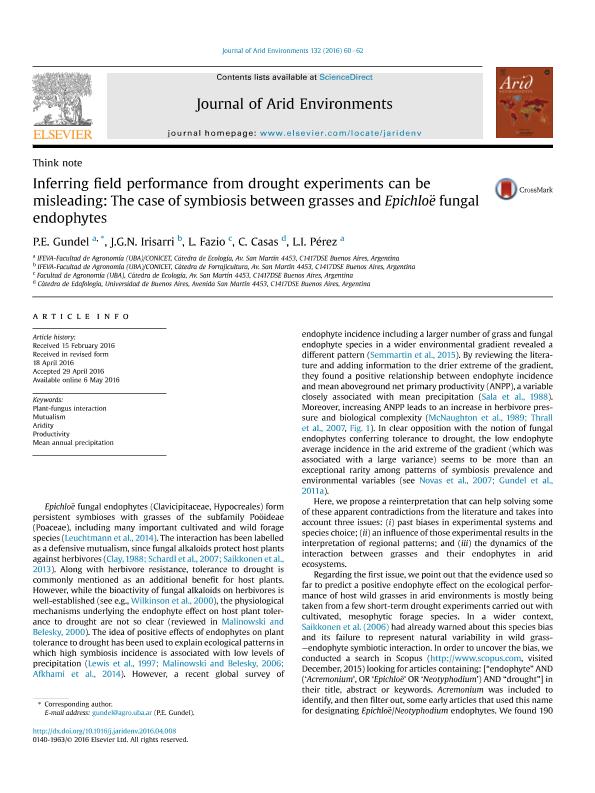Mostrar el registro sencillo del ítem
dc.contributor.author
Gundel, Pedro Emilio

dc.contributor.author
Irisarri, Jorge Gonzalo Nicolás

dc.contributor.author
Fazio, Lucas
dc.contributor.author
Casas, Cecilia

dc.contributor.author
Perez, Luis Ignacio

dc.date.available
2018-07-02T19:54:38Z
dc.date.issued
2016-09
dc.identifier.citation
Gundel, Pedro Emilio; Irisarri, Jorge Gonzalo Nicolás; Fazio, Lucas; Casas, Cecilia; Perez, Luis Ignacio; Inferring field performance from drought experiments can be misleading: The case of symbiosis between grasses and Epichloë fungal endophytes; Academic Press Ltd - Elsevier Science Ltd; Journal of Arid Environments; 132; 9-2016; 60-62
dc.identifier.issn
0140-1963
dc.identifier.uri
http://hdl.handle.net/11336/50917
dc.description.abstract
Epichloe fungal endophytes (Clavicipitaceae, Hypocreales) form persistent symbioses with grasses of the subfamily Pooideae (Poaceae), including many important cultivated and wild forage species (Leuchtmann et al., 2014). The interaction has been labelled as a defensive mutualism, since fungal alkaloids protect host plants against herbivores (Clay,1988; Schardl et al., 2007; Saikkonen et al., 2013). Along with herbivore resistance, tolerance to drought is commonly mentioned as an additional benefit for host plants. However, while the bioactivity of fungal alkaloids on herbivores is well-established (see e.g., Wilkinson et al., 2000), the physiological mechanisms underlying the endophyte effect on host plant tolerance to drought are not so clear (reviewed in Malinowski and Belesky, 2000). The idea of positive effects of endophytes on plant tolerance to drought has been used to explain ecological patterns in which high symbiosis incidence is associated with low levels of precipitation (Lewis et al., 1997; Malinowski and Belesky, 2006; Afkhami et al., 2014). However, a recent global survey of endophyte incidence including a larger number of grass and fungal endophyte species in a wider environmental gradient revealed a different pattern (Semmartin et al., 2015). By reviewing the literature and adding information to the drier extreme of the gradient, they found a positive relationship between endophyte incidence and mean aboveground net primary productivity (ANPP), a variable closely associated with mean precipitation (Sala et al., 1988). Moreover, increasing ANPP leads to an increase in herbivore pres- sure and biological complexity (McNaughton et al., 1989; Thrall et al., 2007, Fig. 1). In clear opposition with the notion of fungal endophytes conferring tolerance to drought, the low endophyte average incidence in the arid extreme of the gradient (which was associated with a large variance) seems to be more than an exceptional rarity among patterns of symbiosis prevalence and environmental variables (see Novas et al., 2007; Gundel et al., 2011a).
dc.format
application/pdf
dc.language.iso
eng
dc.publisher
Academic Press Ltd - Elsevier Science Ltd

dc.rights
info:eu-repo/semantics/openAccess
dc.rights.uri
https://creativecommons.org/licenses/by-nc-sa/2.5/ar/
dc.subject
Aridity
dc.subject
Mean Annual Precipitation
dc.subject
Mutualism
dc.subject
Plant-Fungus Interaction
dc.subject
Productivity
dc.subject.classification
Agricultura

dc.subject.classification
Agricultura, Silvicultura y Pesca

dc.subject.classification
CIENCIAS AGRÍCOLAS

dc.title
Inferring field performance from drought experiments can be misleading: The case of symbiosis between grasses and Epichloë fungal endophytes
dc.type
info:eu-repo/semantics/article
dc.type
info:ar-repo/semantics/artículo
dc.type
info:eu-repo/semantics/publishedVersion
dc.date.updated
2018-06-22T14:40:04Z
dc.journal.volume
132
dc.journal.pagination
60-62
dc.journal.pais
Estados Unidos

dc.description.fil
Fil: Gundel, Pedro Emilio. Consejo Nacional de Investigaciones Científicas y Técnicas. Oficina de Coordinación Administrativa Parque Centenario. Instituto de Investigaciones Fisiológicas y Ecológicas Vinculadas a la Agricultura. Universidad de Buenos Aires. Facultad de Agronomía. ; Argentina
dc.description.fil
Fil: Irisarri, Jorge Gonzalo Nicolás. Consejo Nacional de Investigaciones Científicas y Técnicas. Oficina de Coordinación Administrativa Parque Centenario. Instituto de Investigaciones Fisiológicas y Ecológicas Vinculadas a la Agricultura. Universidad de Buenos Aires. Facultad de Agronomía. ; Argentina
dc.description.fil
Fil: Fazio, Lucas. Universidad de Buenos Aires. Facultad de Agronomia. Departamento de Recursos Naturales y Ambiente. Cátedra de Ecología; Argentina
dc.description.fil
Fil: Casas, Cecilia. Consejo Nacional de Investigaciones Científicas y Técnicas; Argentina. Universidad de Buenos Aires. Facultad de Agronomía. Departamento de Recursos Naturales y Ambiente. Cátedra de Edafología; Argentina
dc.description.fil
Fil: Perez, Luis Ignacio. Consejo Nacional de Investigaciones Científicas y Técnicas. Oficina de Coordinación Administrativa Parque Centenario. Instituto de Investigaciones Fisiológicas y Ecológicas Vinculadas a la Agricultura. Universidad de Buenos Aires. Facultad de Agronomía. ; Argentina
dc.journal.title
Journal of Arid Environments

dc.relation.alternativeid
info:eu-repo/semantics/altIdentifier/url/http://www.sciencedirect.com/science/article/pii/S0140196316300763
dc.relation.alternativeid
info:eu-repo/semantics/altIdentifier/doi/http://dx.doi.org/10.1016/j.jaridenv.2016.04.008
Archivos asociados
